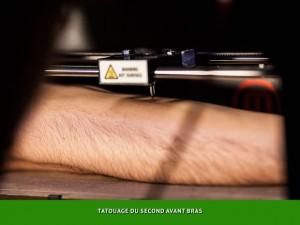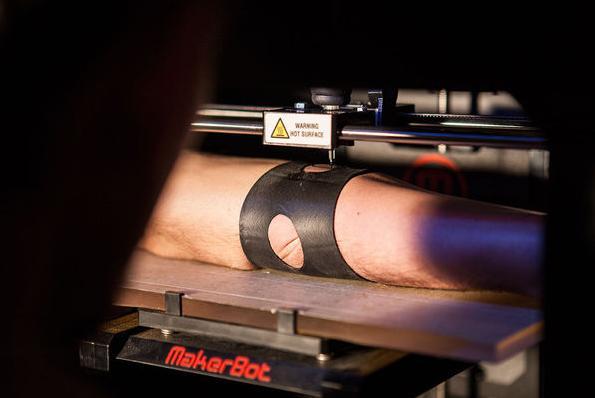The tattoo business is worth billions of dollars a year in the United States alone, and is actually growing as we speak. Tattoo artists are often paid big bucks to permanantly adhere their art to the skin of millions of people a  year. Are these artists at risk of losing their jobs to robots? Perhaps!
year. Are these artists at risk of losing their jobs to robots? Perhaps!
The French Ministry of Culture hosted an event called the “Public Domain Remix”. In which students were given just 8 hours to hack an electronics device. Le FabShop was on hand to help out.
The students split into groups and brainstormed various ideas. One of the groups of students led by Pierre Emm ended up having a brilliant idea, taking a Makerbot Replicator 3D printer, which they already had on hand, and turning it into an automatic computer aided tattoo machine.
What the group did was replace the extruder of the printer with a pen. This allowed the machine to draw on a person just like they were getting a tattoo. The students were not ready to stop there, so they set out to replace the pen with an actual manual tattoo instrument, and it actually worked. They first tested the machine on an artificial skin material, and found that it worked great, but if they were to proceed on a real human being, many precautions and precise calculations had to be made, and more importantly they had to find a volunteer who would become the “guinea pig” for this procedure. Amazingly, finding someone to volunteer was much easier than they thought. Actually a few people wanted to become the first human to be tattooed by a robotic device.
Here are the instructions to build such a machine, via Instructables:
- Install your tatoo tool so that it won’t move at all. You don’t want it to vibrate during the print.
- Mark the center of the build platform.
- Make your drawing in a 3D software if you are using a three axis machine. Give it a minimum thickness of 0,2mm. Try to have only outlines. The trick won’t work to fill surfaces… for the moment.
- Import your drawing in the 3D printing software.
- Measure the length between the platform and the top of the arm you want to tattoo. Then insert the number in the 3D printing software to put the drawing at the good hight. Some 3D printer softwares will automatically put back the drawing to the build plate level. In this case, just create a 0,2×0,2mm cube under your drawing and give it the distance you want. The printer will then adjust its height automatically (since the file’s bottom will be at the good distance).
- You may want to adjust the tension on the skin so your circle wont look oval after removing the rubber. Use a stencil to draw a circle on the skin. Then use the inner tube to give the skin some tension, keeping it stretched uniformly.
- Some 3D printers initialize their XYZ axis by bumping into small sensors, usually at one end of each axis. Since you removed the extruder, you might need to create a small piece which will make the contact between your new tool and the sensors.
- Make sure to sterilize every single element and tools that might be in contact with the human skin.
- Fill your needle with tattoo ink
- Send the drawing to print and pause the machine once it get’s to it’s measured height.
- Place the “volunter’s” arm in the Automatic Tattoo machine and make sure that it’s perfectly centered. Start the motor, cross your fingers and… GO!
- If the skin tension and needle height was measured correctly, every thing should go fine.
Discuss this hacked Makerbot tattoo device at 3dprintboard. Below you will find a video showing the tests that were done using the hacked Makerbot tattoo robot.
Subscribe to Our Email Newsletter
Stay up-to-date on all the latest news from the 3D printing industry and receive information and offers from third party vendors.
You May Also Like
Gorilla Sports GE’s First 3D Printed Titanium Cast
How do you help a gorilla with a broken arm? Sounds like the start of a bad joke a zookeeper might tell, but it’s an actual dilemma recently faced by...
Nylon 3D Printed Parts Made More Functional with Coatings & Colors
Parts 3D printed from polyamide (PA, Nylon) 12 using powder bed fusion (PBF) are a mainstay in the additive manufacturing (AM) industry. While post-finishing processes have improved the porosity of...
$25M to Back Sintavia’s Largest Expansion of Metal 3D Printing Capacity Since 2019
Sintavia, the digital manufacturing company specializing in mission-critical parts for strategic sectors, announced a $25 million investment to increase its production capacity, the largest expansion to its operations since 2019....
Velo3D Initiates Public Offering in a Bid to Strengthen Financial Foundations and Drive Future Growth
Velo3D (NYSE: VLD) has been among a number of publicly traded 3D printing firms that have attempted to weather the current macroeconomic climate. After posting a challenging financial report for 2023,...
































